
Melody Ranch is a 1940 Western musical film directed by Joseph Santley and starring Gene Autry, Jimmy Durante, and Ann Miller. Written by Jack Moffitt, F. Hugh Herbert, Bradford Ropes, and Betty Burbridge, the film is about a singing cowboy who returns to his hometown to restore order when his former childhood enemies take over the frontier town. In 2002, the film was added to the National Film Registry by the National Film Preservation Board and selected for preservation as being "culturally, historically, or aesthetically significant."

Roy Rogers was an American singer, actor, and television host. Following early work under his given name, first as co-founder of the Sons of the Pioneers and then acting, the rebranded Rogers then became one of the most popular Western stars of his era. Known as the "King of the Cowboys", he appeared in over 100 films and numerous radio and television episodes of The Roy Rogers Show. In many of his films and television episodes, he appeared with his wife, Dale Evans; his Golden Palomino, Trigger; and his German Shepherd, Bullet. His show was broadcast on radio for nine years and then on television from 1951 through 1957. His early roles were uncredited parts in films by fellow cowboy singing star Gene Autry and his productions usually featured a sidekick, often Pat Brady, Andy Devine, George "Gabby" Hayes, or Smiley Burnette. In his later years, he lent his name to the franchise chain of Roy Rogers Restaurants.

Thomas J. Moore was an Irish-American actor and director. He appeared in at least 186 motion pictures from 1908 to 1954. Frequently cast as the romantic lead, he starred in silent movies as well as in some of the first talkies.

Producers Releasing Corporation was the smallest and least prestigious of the Hollywood film studios of the 1940s. It was considered a prime example of what was called "Poverty Row": a low-rent stretch of Gower Street in Hollywood where shoestring film producers based their operations. However, PRC was more substantial than the usual independent company that made only a few low-budget movies and then disappeared. PRC was an actual Hollywood studio – albeit the smallest – with its own production facilities and distribution network, and it even accepted imports from the UK. PRC lasted from 1939 to 1947, churning out low-budget B movies for the lower half of a double bill or the upper half of a neighborhood theater showing second-run films. The studio was originally located at 1440 N. Gower St. from 1936 to 1943. PRC then occupied the former Grand National Pictures physical plant at 7324 Santa Monica Blvd., from 1943 to 1946. This address is now an apartment complex.

Born to Kill is a 1947 American film noir co-starring Lawrence Tierney, Claire Trevor and Walter Slezak, with Esther Howard, Elisha Cook Jr., and Audrey Long in supporting roles. Directed by Robert Wise for RKO Pictures, the feature was the first film noir production by Wise, whose later films in the genre include The Set-Up (1949) and The Captive City (1952).

Charles Robert Starrett was an American actor, best known for his starring role in the Durango Kid westerns. Starrett still holds the record for starring in the longest series of theatrical features: 131 westerns, all produced by Columbia Pictures.

Fred J. Balshofer was a pioneering silent film director, producer, screenwriter, and cinematographer in the United States.
Grand National Films, Inc was an American Poverty Row motion picture production-distribution company in operation from 1936 to 1939. The company had no relation to the British Grand National Pictures.

Sally of the Scandals is a 1928 American silent crime drama film produced and released by Film Booking Offices of America. It was directed by Lynn Shores and starred Bessie Love.
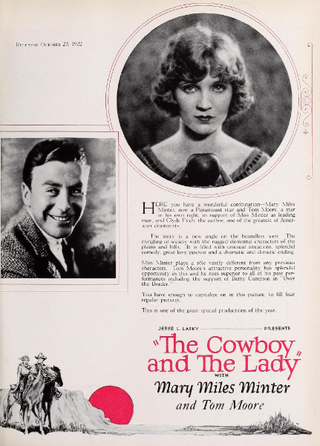
The Cowboy and the Lady is a 1922 American silent Western film directed by Charles Maigne and starring Mary Miles Minter and Tom Moore. It was adapted by Julien Josephson from the 1908 play of the same name by Clyde Fitch, and was shot on location at Jackson Hole in Wyoming. As with many of Minter's features, it is thought to be a lost film.
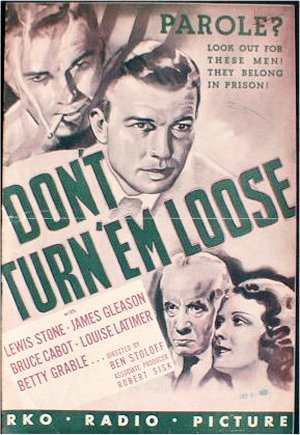
Don't Turn 'Em Loose is a 1936 American crime drama film directed by Ben Stoloff and produced by RKO Radio Pictures, who released the film on September 18, 1936. Written by Harry Segall and Ferdinand Reyher, the production's screenplay is at least partially based on "Homecoming" by Thomas Walsh, a short story published in Collier's magazine in March 1936. The film costars Lewis Stone, James Gleason, Bruce Cabot, Louise Latimer and Betty Grable.
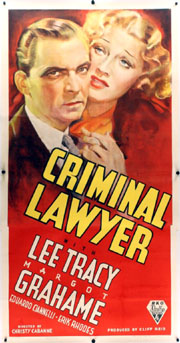
Criminal Lawyer is a 1937 American drama film directed by Christy Cabanne from a screenplay by G. V. Atwater and Thomas Lennon, based on a story by Louis Stevens. The film stars Lee Tracy, Margot Grahame and Eduardo Ciannelli. RKO produced the film and premiered it on January 26, 1937, in New York City, with a national release a few days later on January 29. It was the second time Stevens' story had been used for a film, the first being 1932's State's Attorney, starring John Barrymore and Helen Twelvetrees, directed by George Archainbaud, and also produced and released by RKO.
Charles R. Rogers, was an American film producer whose career spanned both the silent and sound film eras. Rogers began his career on the 1924 silent film, A Cafe in Cairo, produced by the short-lived Hunt Stromberg Productions. After Stromberg ceased productions in 1925, Rogers would found his own independent company, Charles R. Rogers Productions. He would also produce for major studios such as RKO Radio Pictures, Universal, and United Artists. The pinnacle of his career would be from 1936 to 1938 when he was chosen as the vice-president in charge of production for Universal Pictures. He died as the result of injuries sustained in a car accident in 1957.
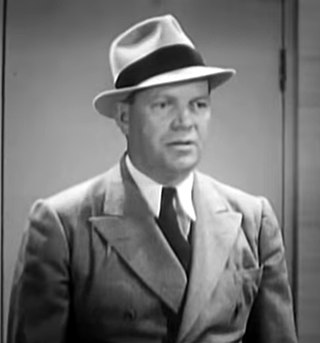
John F. Kelly was an American actor whose career spanned the very end of the silent film era through the 1940s. While most of his parts were smaller, often-uncredited roles, he was occasionally given a more substantial supporting or even featured role.
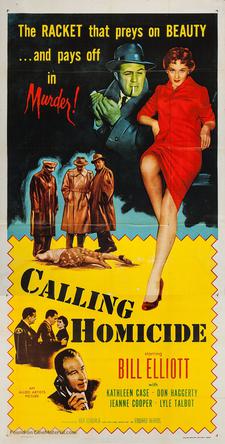
Calling Homicide is a 1956 American police drama film directed by Edward Bernds and starring Bill Elliott, Don Haggerty and Kathleen Case. The picture was the third of five films in the Lt. Andy Doyle series, all starring Elliott.

Sweet Lavender is a 1920 American silent drama film directed by Paul Powell and starring Mary Miles Minter. The scenario was adapted by Beulah Marie Dix from the 1888 play of the same name by Arthur Wing Pinero. Like many of Minter's features, it is thought to be a lost film.

The Average Woman is a 1924 American silent melodrama film directed by Christy Cabanne and starring Pauline Garon, David Powell, and Harrison Ford. It was released on March 1, 1924.

Alias – the Bad Man, also known as Alias Bad Man, is a 1931 American pre-Code Western film, directed by Phil Rosen and starring Ken Maynard, Virginia Brown Faire, and Frank Mayo. It was released on July 15, 1931.

The Blazing Trail, known in the United Kingdom as The Forged Will, is a 1949 American Western film directed by Ray Nazarro and starring Charles Starrett.

Call of the Rockies is a 1938 American Western film directed by Alan James, starring Charles Starrett, Donald Grayson, and Iris Meredith.


















